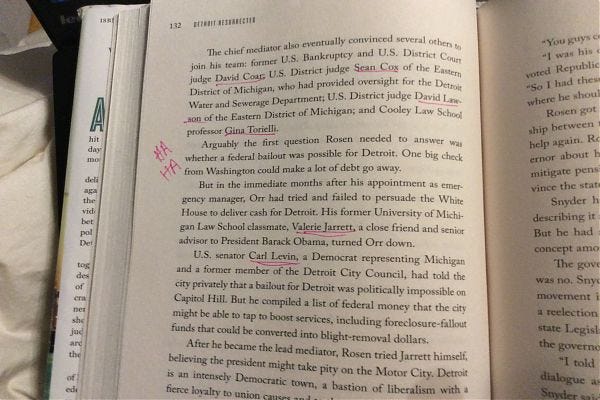The Detroit bankruptcy was filed in federal court in July 2013, and I look at the history since then. There is a lawsuit going on right now in 2023, involving the Detroit police and fire pension fund, which relates to its deal from the bankruptcy workout. In addition, the school system wasn’t involved in the bankruptcy. I look at STUMP’s coverage of Detroit’s woes over the past decade.
Episode Links

Reason article
A Decade After Bankruptcy, Is Detroit Better?
If there is a lesson from Detroit's 2013 bankruptcy, it's that going broke can only take a city so far. Municipal bankruptcy is a process that gets a city out of debts that it can't pay. But city residents don't get better services when those debts are canceled.
There are some things that ought to surprise people about city finances. When Detroit filed for bankruptcy in July 2013, residents found out that the group the city owed the most money to was not banks or bondholders or city contractors—it was the city's pensioners. Former city employees accidentally became Detroit's largest creditors because the city didn't have enough money to pay them what they were owed.
This should not be. When governments promise to pay their employees pensions, they should set aside enough money to pay for them. This keeps the cost of pensions on current taxpayers and doesn't push the costs into the future.
Detroit News article
Detroit police, fire pensioners push back on bankruptcy ruling to extend payments
The Police and Fire Retirement System of Detroit filed on Monday a motion for reconsideration, pushing back on a federal bankruptcy judge's ruling in favor of the Duggan administration's plan to extend the city's pension payment obligations over 30 years rather than 20 years.
The city's police and fire retirees are continuing litigation that has been ongoing since August when the city administration initially filed suit against the pension system to enforce a 30-year pay-out schedule. On June 26, Judge Thomas Tucker ruled in the city's favor, stating that a 30-year amortization period is "indeed part of the (bankruptcy) Plan of Adjustment and that the Police Fire Retirement System cannot change it."
The new motion seeks clarification of the court's possible imposition of a 6.75% rate of return that was specifically set to expire after 10 years under the Plan of Adjustment, the bankruptcy exit plan. After June 30, the pension fund's rate of return and its amortization funding policy are within the purview of the Police and Fire Retirement System's Board of Trustees and Investment Committee, according to the pensioners' filing.
At the 30-year determined rate, the city will complete its debt obligations in 2054. Police and fire retirees want their pension fund to be made whole sooner.
STUMP posts
2014: Detroit Bankruptcy: It's Over, But It's Not
Various valuation/funding practices were nixed for private DB plans (as per ERISA) because they made the plans less safe for participants in the event of a pension sponsor bankruptcy.
Why do some public DB plans still use these approaches? The obvious answer is that it makes pensions look cheaper than they actually are, or that they keep pushing off til years later what they should be paying today, but one still needs cover of a sort to get away with it.
The justification often used for these approaches is: “governments don’t go out of business.” Also, some of these governmental entities cannot file for bankruptcy.
But just because there’s no established legal bankruptcy process does not mean governments cannot go bankrupt in fact. Because they obviously do.
Just because there’s no formal bankruptcy process for states does not mean that Illinois can’t ever go bankrupt. Or California. Or New Jersey. Or Rhode Island. They can, and I won’t be surprised if several will over the next twenty years. (And no, there won’t be federal bailouts. Not all states have these problems, and certainly not to the extent of the worst players above.)
That’s why I bolded the particular statement from the SOA letter. It is an acknowledgement that there is no magical pot of money that will fill all unfunded liabilities some time in the nebulous future.
This is a problem for Detroit. Even if they didn’t have various parties suing and appealing over the bankruptcy workout, or huge fees paid to consultants and lawyers as part of the plan, they could be seeing a return to bankruptcy court when they really can’t pay the pensions.
2016: The Connections Between Detroit and Chicago Public Schools
We know about the CPS financial squeeze, and they’re looking for a bailout from the Illinois statehouse — Detroit Public Schools is in a similar plight:
2016: Detroit Resurrected by Nathan Bomey: a Review
Nathan Bomey created a compelling narrative out of the bankruptcy workout of Detroit, lasting from July 2013 to December 2014. One expects an epic fight from the largest municipal bankruptcy ever (so far), but what I came across was unexpected – a fast-paced narrative detailing the major players, and most importantly, letting those players explain themselves.
(An aside: for the prim, I will warn there’s a lot of “NYC language” coming from particular players. It’s not Games-of-Thrones bad; after all, nobody gets killed (SPOILER ALERT!), no sexy romps, and definitely a dearth of direwolves. But yes, plenty of strong opinions uttered using vulgarities.)
It was so refreshing to see the narrative played out where there are no real villains except some hazy groups (like a hapless City Council) and the definitely-named Kwame Kilpatrick. But he’s off-stage by the beginning of the book, being bundled off to federal prison, along with some of his cronies. But even the biggest losers in the deal, bond insurers FGIC and Syncora, get their say. They’re not made out to be eeeeevil Wall Street players, but players representing their own interests and making their own claims for fairness. The only Detroit institution leaving unscathed in the deal was the art museum, DIA. One gets to hear of the sense of betrayal by all the players, within and without Detroit, without their particular pain being mocked.
The book has plenty of conflict, surprising alliances, and a few interesting twists at the end (which cleared up some mysteries to me at the time.) I thought the pacing was really well-done, and Bomey did a good job of explaining salient technical points, like present value, relatively quickly and enough detail for the lay reader to understand. Excellent book for the general public. It will also be a great study for law and business schools for people learning about negotiation in high stakes situations that seem like zero sum.
If Bomey takes this level of detail and even-handedness to all his journalistic work, as well as the storytelling ability, he will go far in journalism.
Bomey actually has been doing pretty well.
After his stint in Detroit, he went to USA Today and to Axios. I like his work.
2018: Happy Public Finance Story: The Bankruptcy of Detroit Brings Good Results
Just the headlines version:
HAPPY NEWS: DETROIT IS RESPONSIBLE FOR ITSELF AGAIN
SEPARATE HAPPY NEWS: BUSINESSES INVESTING IN DETROIT
CLOUDS ON THE HORIZON
Demographic History of Detroit
Wikipedia: Demographic History of Detroit















Share this post